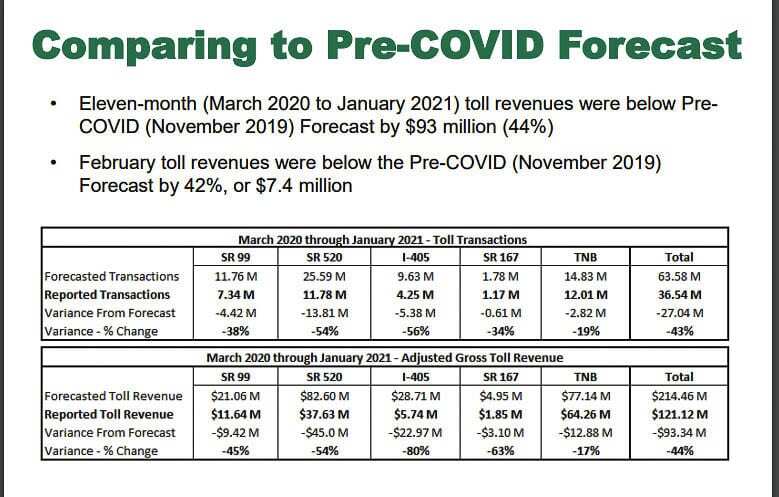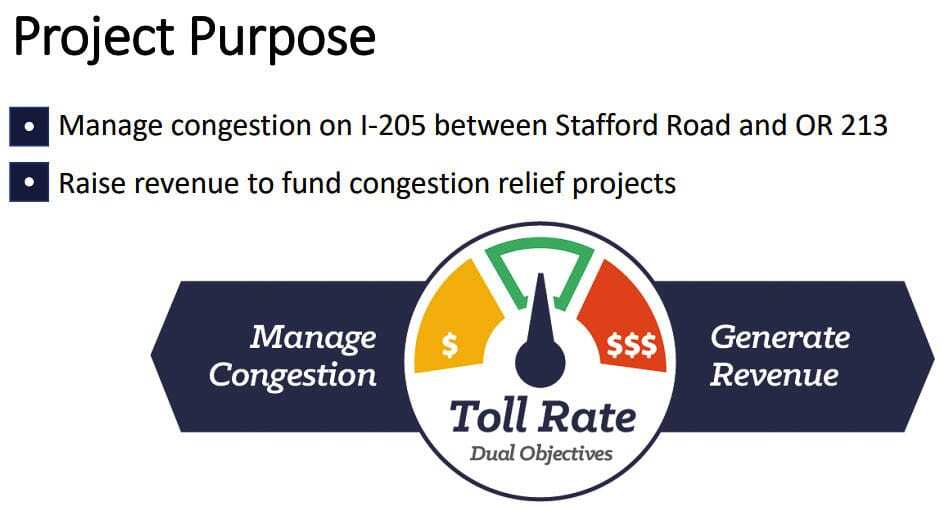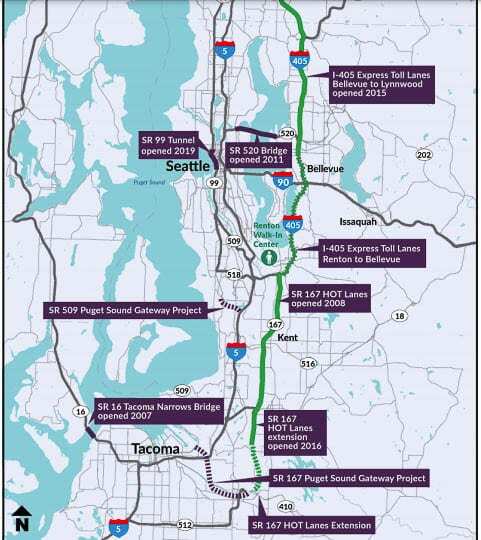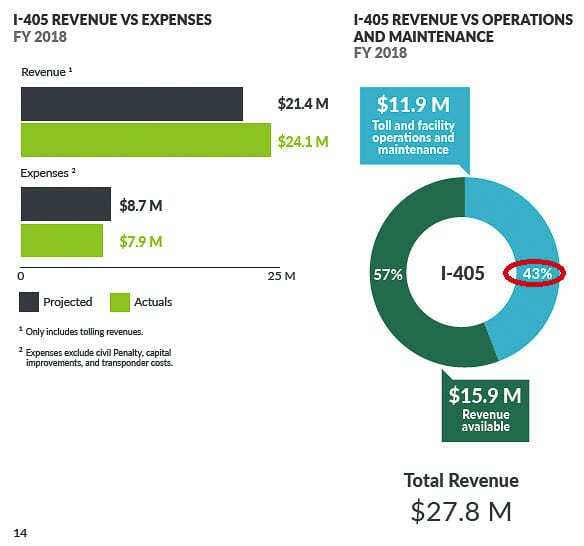State losing money on I-405/SR 167 tolling in 2021
A 2021 Washington State Transportation Commission (WSTC) report indicates significant financial problems in the state’s tolling system. The WSTC oversees five different tolling projects in the state. All are now experiencing financial hardships due to declining tolling revenues.
For the first six months of Fiscal Year 2021, the state tolling program lost $5 million on the I-405 and SR 167 system. The state treasurer is concerned about the state possibly defaulting on federal TIFIA loans made for SR 520 that crosses Lake Washington.
For an 11-month period, total revenue on I-405 was 80 percent below the pre COVID forecast. “We really see the pronounced effect that the pandemic is having on express toll lanes,” said Edward Barry, head of WSDOT’s Tolling Division.
Tolls are sold as a user fee, and a way to raise needed funds for specific transportation projects and for transportation funding in general. Here in the Portland metro area, Oregon is hoping to begin tolling on both I-5 and I-205 before the decade is over.
In its March newsletter on their proposed tolling program for the Portland metro area, ODOT said the following.
Tolling is a widely used industry term to describe road pricing programs. It is worth clarifying upfront that ODOT is using ‘tolling’ as an umbrella term for the program, which is expected to include various types of tolling such as congestion pricing (also known as variable rate pricing), and other applications needed to generate revenue and manage congestion.
The two toll projects underway have a dual purpose: manage congestion and generate revenue. We are working to identify a balanced toll rate that enhances traffic flow while generating revenue for transportation improvements. A toll that is too low won’t manage congestion well. A toll that is too high leads to too many highway drivers using local streets. With a balanced toll more people benefit from improved travel on the highway and throughout the region.
We get it — no one likes paying tolls or fees. But like the cost of any service — it’s all about what you get for the amount you pay. In Oregon, the benefit of paying a toll will be a faster trip with less traffic. Congestion pricing will give people the choice for a faster highway trip when they really need it — like when they’re late for work or need to pick up their child from school or daycare.

On the I-405 and SR 167 highways, Washington added new vehicle lanes, adding capacity. ODOT is not proposing to do that on I-5 and for their tolling program which will begin “at the border with Washington” and continue on both I-5 and I-205 to where they meet near Wilsonville.
For I-205, ODOT wants to use the funds to do a seismic upgrade to the Abernethy Bridge near Oregon City. It proposes adding a lane on the bridge and a 6-mile stretch to Stafford Rd. But nothing on Interstate 5, the most congested corridor in the region.
Metro President Lynn Peterson told the Executive Steering Group of the Interstate Bridge Replacement Project (IBRP) last month that Portland has a policy of allowing just 3 lanes in each direction on highways and freeways. She wants that restriction included in the Purpose and Need statement for the IBRP. Portland Commissioner Jo Ann Hardesty wants to get people out of their cars.
The tolling revenue crisis
Total toll revenue collections for all five Washington tolled facilities is projected to generate just over $325 million during the current biennium (July 1, 2019 – June 30, 2021). That is down by 28 percent from pre-pandemic projections, or $128 million less than expected. This decline in revenue is about 20-80 percent below forecasted levels between March – October 2020, depending on the facility.
“These impacts have severely stressed the capacity of toll facilities to meet financial requirements,” reports the WSTC. “Initial steps to address these requirements began in 2020 and additional steps will be necessary in 2021, and possibly beyond.”
Worst among these financial problems are the I-405 HOT lanes. They have experienced an 81 percent drop in tolling revenues. “This decline in traffic has greatly reduced toll revenues for each toll facility, with the largest impacts on facilities in the urban core of central Puget Sound,” reports the WSTC.
This should be an ominous warning to ODOT, as they hope to fund portions of the I-5 Rose Quarter project with tolling revenues. It has already ballooned from an initial cost projection of $450 million to $795 million. ODOT officials don’t even have a final agreed upon plan for the lids over I-5, nor the width of the freeway through this chokepoint.

Additionally, planners and politicians are hoping tolling will potentially generate significant revenues for a replacement Interstate Bridge. While there is no specific project yet, the IBRP team briefed legislators that a project could run $4 billion to $5 billion last fall. Administrator Greg Johnson regularly touts tolling as a source of funding.
The WSTC says that due to on-going COVID-19 related impacts on traffic volumes, the legislature should consider various options to supplement toll revenues with other state funds.
These additional funds are needed to pay toll facility costs such as for facility operations, maintenance, or preservation, consistent with non-tolled facilities. The support would enable a quicker replenishment of currently depleted facility reserve funds, such as the revenue stabilization accounts for SR 520 and SR 99, than relying on toll revenues alone, according to the WSTC recommendations.
The Commission is also monitoring current processes and on-going analysis of two potential projects that may include tolls. They are the replacement of the I-5 Bridge over the Columbia River and the replacement of the US 2 Westbound Trestle in Snohomish County. “Engagement during the planning phases of these authorized and potential tolling projects informs the Transportation Commission’s eventual rate-setting processes should tolling be utilized,” reports the WSTC.
Other tolling facilities are also hard hit. The SR 167 revenue dropped 63 percent; SR 520 floating bridge toll revenue dropped 54 percent; the SR 99 tunnel (Big Bertha) dropped 45 percent; and the Tacoma Narrows Bridge tolling revenues dropped the smallest percentage at 17 percent.
Tolling director Ed Barry said it isn’t really getting much better. The new February tolling numbers show revenues off over 8 percent from the November 2020 projections.
“It remains to be seen as we come out of the pandemic and people perhaps go back to work or do different things, how the toll revenue might behave,” Barry told the WSTC last week. “It’s still pretty difficult to tell exactly what the new normal will look like.”
The state treasurer has evaluated the SR 520 tolling finances. There are projections of a $14.3 million revenue gap for meeting FY 2021 financial requirements. Not meeting these requirements could result in a potential default on federal TIFIA debt service payments of $9.8 million, according to the WSTC report.
The WSTC is recommending the legislature appropriate the excess fund balance in the SR 520 Civil Penalties Account to support activities related to SR 520 bridge operations and maintenance. Additionally, to support meeting financial requirements in FY 2022 and beyond, consider options to further defer or extend sales tax repayment. Repayment of sales tax on SR 520 construction is scheduled for FY 2022 – FY 2032.
The WSTC also suggests the legislature consider the possibility of tolling existing HOV lanes on additional freeways to provide an infusion of revenues.

The high cost of collection
There appears to be increasing evidence that tolls are an inefficient means of raising money from taxpayers for transportation projects. The state Tolling Division in its 2018 Annual Report indicated that I-405 tolling took in $27.8 million. They spent $11.9 million in tolling facility and operations maintenance costs, leaving a “net” of $15.9 million to buy new traffic lanes and fund other transportation improvements.
“The important thing to realize is that 43 percent of drivers’ tolling dollars go towards the ‘cost of collection’ and maintaining the tolling facilities,” Clark County Today reported last year.
It got better in 2019 as the cost of collection on I-405 dropped to 40 percent, with $33 million in revenues and $13.4 million in expenses. But then COVID-19 and Governor Inslee’s “stay home, stay safe” order was issued in 2020.
The 2020 WSTC report showed $30.6 million in revenue and $25 million in expenses, an 81 percent cost of collection. Included was a $11 million “capital outlay” for the year. In previous years, $3 million had been spent on capital outlays.
The first half of FY 2021 shows even worse financial numbers. The cost of collection exceeded tolling revenues by $5 million — a net loss to the system. There was $5.1 million in revenues versus $10.2 million in expenses.
These numbers demonstrate the volatility of tolls as a revenue source and the risks of borrowing money against future tolling revenues.

WSDOT provided Clark County Today with an explanation of the “capital outlays” made with tolling funds from the I-405 HOT/Express lanes. As directed by the Legislature, express toll lane revenue can only be used for two reasons: to cover operating costs, and for improvements to the I-405 corridor.
The first project is the I-405, SR 522 Vicinity to SR 527 Express Toll Lanes Improvement Project, which included $10.6 million for engineering and right-of-way that was allocated in fiscal year 2020, and $4.5 million in fiscal year 2021. This project will:
- widen I-405 through the SR 522 interchange.
- build direct access ramps to the express toll lanes at SR 522.
- build a partial direct access ramp at SR 527.
- extend the express toll lane system between SR 522 and SR 527.
The second project is the SR 167/SR 410 to SR 18 NB Congestion Management Project, which included $444,524 for engineering that was allocated in fiscal year 2020, and $1.4 million in fiscal year 2021. This project will:
- add an HOV lane on SR 167 near SR 410.
- extend the existing SR 167 HOT Lane near Auburn.
- add new traffic devices such as cameras and ramp meters to the corridor.
The $3.2 million expenditure from fiscal year 2018 funded improvements to I-405 such as the Northbound Peak-Use Shoulder Lane Project, which added 1.8 miles of new capacity for general purpose traffic from SR 527 to I-5.
Borrowing against tolls
In the 2019 Democrat-controlled Washington State Legislature, HB 2132 and SB 5825 were passed. The legislation allowed the state to bond and borrow up to $1.5 billion in future toll revenue from Wall Street banks. Voting in favor of this legislation, locally, were Sen. Annette Cleveland and Reps. Sharon Wylie and Monica Stonier, all representing the 49th Legislative District.
The alleged purpose was to accelerate the construction of three “much needed” transportation projects in the Puget Sound area. Senate Bill 5825 primarily authorizes the expansion of tolling on I-405 and SR 167. It was the need for “immediate gratification” driving the legislature’s decision to live on the taxpayers credit card and allow bonding of future toll revenues.
“Current tolling revenues will not cover a $1.5 billion debt. Picking the pockets of vehicle drivers will have to triple current toll revenues to cover borrowing $1.5 billion from Wall Street,” was stated in a Clark County Today opinion piece.
Now, it appears that prediction has come true. Instead of contributing money for regional transportation projects, the Puget Sound tolling of I-405 and SR 167 is consuming other transportation dollars.
Tolling dollars are proving to be a volatile source of taxpayer money. They are regressive, harming the poor the most. The Washington State Legislature directed the WSTC to study a low income tolling program last year. That report is due later this year.
Last year, Sen. Phil Fortunato (Republican, 31st District) said: “there’s no incentive to reduce congestion – because that could reduce the revenue stream and affect the bond payoff.” That’s exactly what has happened on the SR 520 bridge loans. Plus the I-405 and SR 167 tolls are not covering the cost to collect them in the current year.
Isn’t reducing congestion and making faster, more convenient and reliable trips what transportation spending is supposed to be all about?
The COVID-19 pandemic and lockdown of the state has significantly reduced not only tolling revenues, but also mass transit ridership. It remains to be seen if these changes will be permanent or not.
A report last summer from the International Bridge, Tunnel and Turnpike Association (IBTTA) indicates that many of America’s major tolling agencies continue to experience significant revenue impacts due to the ongoing COVID-19 pandemic.
“Transportation has seen many catastrophic events in our history, from the 1989 Bay Area Earthquake to [the terrorist attacks of] September 11th, and Superstorm Sandy,” Patrick Jones, IBTTA’s executive director and CEO, explained in a statement. “But the ongoing impact of the COVID-19 pandemic on transportation systems across the globe is a different beast altogether.”
The WSTC is now seeking other possible sources of revenues or the ability to shift taxpayer dollars between programs, in order to shore up tolling division finances. They are also suggesting expanding tolling to other highways in order to raise money in a search for “stable funding.” One suggestion includes converting existing HOV lanes to tolled lanes.
Do people want to pay to drive on highway lanes they have already paid for? How will the Washington legislature deal with the unstable funding in the tolling division? More important to Southwest Washington citizens is the question of tolling to drive on the Portland metro area highways or to use a new Interstate Bridge.




